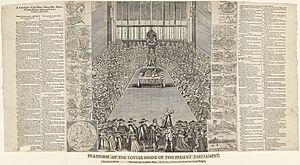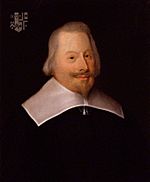Army Plots (1641) facts for kids
The 1641 Army Plots were two secret plans. They involved supporters of Charles I of England trying to use the army. Their goal was to stop the Parliament from opposing the king. This happened just before the First English Civil War began.
The main idea was to move the army from York to London. This would help the king regain his power. There were also claims that the plotters wanted help from the French army. They supposedly planned to take over towns and turn them into strongholds for the king's side.
When these plots were discovered, John Pym and other Parliament leaders gained an advantage. They were able to imprison or send away many of the king's supporters. This included the king's wife, Henrietta Maria. It's still not fully clear who exactly planned what. However, there were real attempts to move troops to London.
Contents
The First Army Plot: A Secret Plan Uncovered

The first secret plan, called the "First Army Plot," happened between March and May 1641. King Charles I had lost a war called the Bishops' Wars. Parliament was called back in November 1640. It began to take action against the king's advisors. Charles still wanted to get his power back.
He hoped to break the alliance between the Scots and his opponents in Parliament. This hope ended in February. The Scots demanded that one of the king's advisors, Strafford, be punished. They also wanted to remove bishops from the Church of England. Parliament refused to condemn the Scots. Charles then realized he could not agree with his critics.
Soldiers' Unhappiness and New Ideas
At the same time, English soldiers were unhappy. Parliament had given money meant for their pay to the Scots instead. This made the officers very angry. They often paid for things themselves first. They depended on getting paid back later.
The officers wrote a letter about their complaints. A captain named James Chudleigh brought it to London. He shared its contents with some important people. These included the poet William Davenant and John Suckling.
George Goring suggested a bold plan. He proposed that the army in York march south. This would threaten Parliament. He also planned to take over Portsmouth. This port would be a place for outside help to land.
Another part of the plan involved Suckling and Henry Jermyn. They wanted to take control of the Tower of London. This was linked to a plan to free Strafford, who was held there. Meanwhile, Henry Percy was also trying to get money for the army from Parliament.
The Plot's Discovery and Aftermath
Percy and Goring met with the king and queen. They talked about bringing the main army south. Rumors started that the king would lead the army. People also said French troops would come to help. However, most of the soldiers refused to join the plan. So, it was stopped.
Goring told Mountjoy Blount, 1st Earl of Newport about the plans. Blount then shared this information with John Pym, a leading Parliament member. This happened in April. Davenant and Suckling still tried to take the Tower. Soldiers loyal to the king were put in place. But Parliament soon found out. Soldiers loyal to Parliament quickly took control of the Tower.
An investigation followed. Many claims were made about the king and queen. It was said they were trying to get French military help. People claimed the queen sent her own money to Portsmouth. Goring was in charge there. The idea was to turn it into a Royalist stronghold. Evidence also showed the king was raising money. He wanted to win over military men to his side.
As soon as the plot was found out, Percy tried to escape to France. But he was attacked and hurt. He had to go into hiding. He wrote a letter to his brother. This letter described what happened. Parliament later used it as proof of the plot. After he was caught, he tried to blame others. The king's supporters criticized him for betraying the king. Goring also distanced himself from Davenant and Suckling's plans. He submitted to Parliament. This allowed him to keep control of Portsmouth.
The failure of this plot had big consequences. Strafford faced severe punishment and was removed from power. Many moderate Royalists also became less supportive of the king.
The Second Army Plot: Another Attempt to Control

A few months later, in May, rumors of a second plot began. King Charles sent Daniel O'Neill to talk with army leaders. He suggested they move their forces south. This would "protect" both the king and moderate Parliament members. O'Neill also tried to make sure the Scots government stayed neutral. Scotland was separate from England at that time. Charles was king of both.
Pym tried to get support to put local militias on alert. This was to prepare for the proposed army move. But again, the plan did not get enough support from army commanders.
William Legge was involved in the second plot. He had been questioned after the first one. Along with two other members of Parliament, Henry Wilmot, 1st Earl of Rochester was removed from the Long Parliament in December 1641. He was accused of being involved in the Second Army Plot. He was then arrested. O'Neill escaped to France. But he soon returned and was arrested and imprisoned. This time, Percy was also removed from Parliament in December. After that, he too left for France.
Consequences of the Army Plots
The two army plots made the differences between the king and Parliament even stronger. They also helped Parliament gain more power. Parliament could see how much support the king had among army commanders.
Pym was also able to set up conditions for local militias. These groups supported Parliament. They could defend towns that the Royalists might threaten. Leading Royalists were either forced to leave the country or lost their power. This further strengthened Parliament's position.
These events made it clear that the king could not force his will. He tried to arrest his main opponents in Parliament in January 1642. But he had no army support, and it failed completely. He fled from London to his strongholds a few days later. The queen left the country.
When Charles decided to fight, Goring, who still controlled Portsmouth, immediately declared for the king. Jermyn and Davenant both returned to England to join the king. O'Neill escaped from prison in 1642. He also joined the Royalists. Percy and Wilmot joined the Royalists too. However, they later lost the king's favor. This was because they suggested talking with Parliament.



